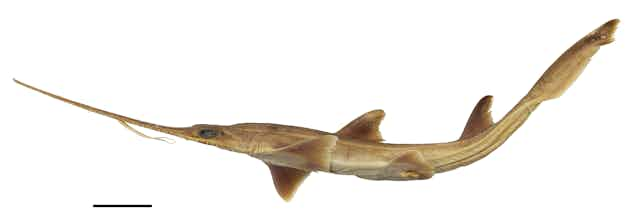Finding a species that’s entirely new to science is always exciting, and so we were delighted to be a part of the discovery of two new sixgill sawsharks (called Pliotrema kajae and Pliotrema annae) off the coast of East Africa.
We know very little about sawsharks. Until now, only one sixgill species (Pliotrema warreni) was recognised. But we know sawsharks are carnivores, living on a diet of fish, crustaceans and squid. They use their serrated snouts to kill their prey and, with quick side-to-side slashes, break them up into bite-sized chunks.

Sawsharks look similar to sawfish (which are actually rays), but they are much smaller. Sawsharks grow to around 1.5 metres in length, compared to 7 metres for a sawfish and they also have barbels (fish “whiskers”), which sawfish lack. Sawsharks have gills on the side of their heads, whereas sawfish have them on the underside of their bodies.

Together with our colleagues, we discovered these two new sawsharks while researching small-scale fisheries that were operating off the coasts of Madagascar and Zanzibar. While the discovery of these extraordinary and interesting sharks is a wonder in itself, it also highlights how much is still unknown about biodiversity in coastal waters around the world, and how vulnerable it may be to poorly monitored and managed fisheries.

Fishing in the dark
Despite what their name might suggest, small-scale fisheries employ around 95% of the world’s fishers and are an incredibly important source of food and money, particularly in tropical developing countries. These fisheries usually operate close to the coast in some of the world’s most important biodiversity hotspots, such as coral reefs, mangrove forests and seagrass beds.
For most small-scale fisheries, there is very little information available about their fishing effort – that is, how many fishers there are, and where, when and how they fish, as well as exactly what they catch. Without this, it’s very difficult for governments to develop management programmes that can ensure sustainable fishing and protect the ecosystems and livelihoods of the fishers and the communities that depend on them.

While the small-scale fisheries of East Africa and the nearby islands are not well documented, we do know that there are at least half a million small-scale fishers using upwards of 150,000 boats. That’s a lot of fishing. While each fisher and boat may not catch that many fish each day, with so many operating, it really starts to add up. Many use nets – either driftnets floating at the surface or gillnets, which are anchored close to the sea floor. Both are cheap but not very selective with what they catch. Some use longlines, which are effective at catching big fish, including sharks and rays.
Read more: Sharks: one in four habitats in remote open ocean threatened by longline fishing
In 2019, our team reported that catch records were massively underreporting the number of sharks and rays caught in East Africa and the nearby islands. With the discovery of two new species here – a global hotspot for shark and ray biodiversity – the need to properly assess the impact of small-scale fisheries on marine life is even more urgent.

How many other unidentified sharks and other species are commonly caught in these fisheries? There is a real risk of species going extinct before they’re even discovered.
Efforts to monitor and manage fisheries in this region, and globally, must be expanded to prevent biodiversity loss and to develop sustainable fisheries. There are simple methods available that can work on small boats where monitoring is currently absent, including using cameras to document what’s caught.

The discovery of two new sixgill sawsharks also demonstrates the value of scientists working with local communities. Without the participation of fishers we may never have found these animals. From simple assessments all the way through to developing methods to alter catches and manage fisheries, it’s our goal to make fisheries sustainable and preserve the long-term future of species like these sawsharks, the ecosystems they live in and the communities that rely on them for generations to come.

